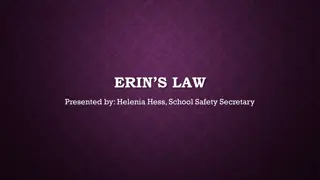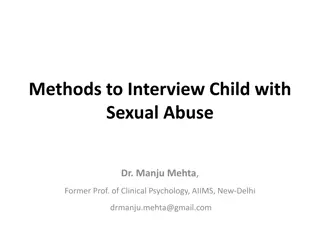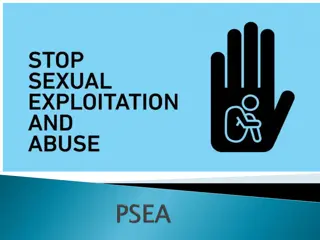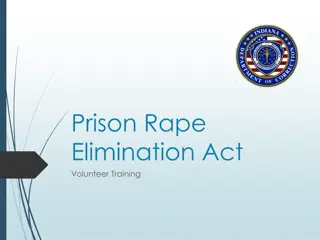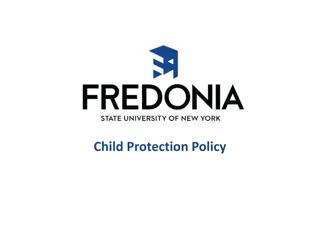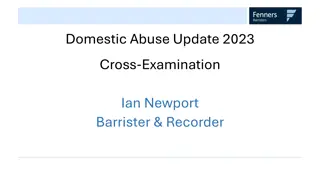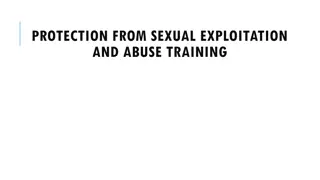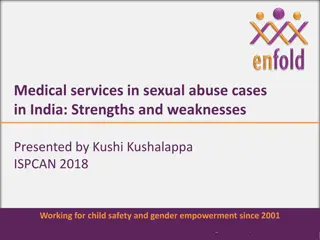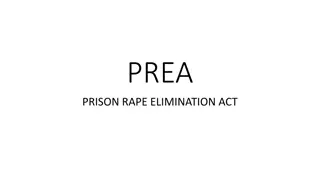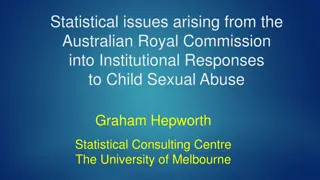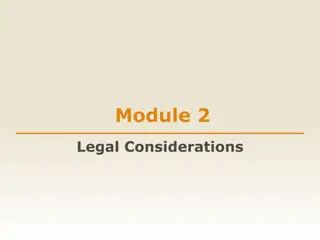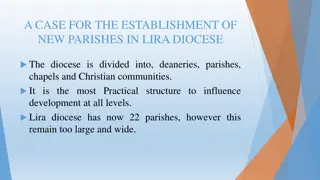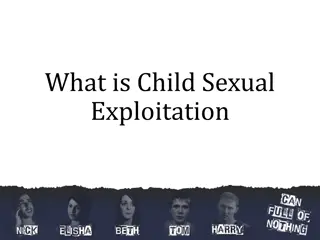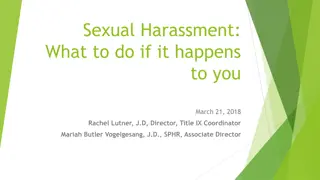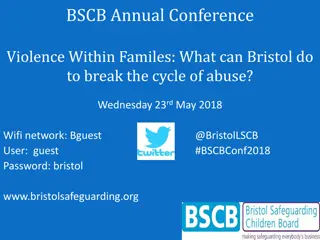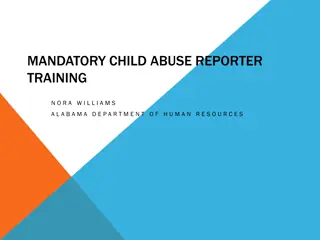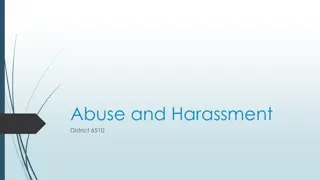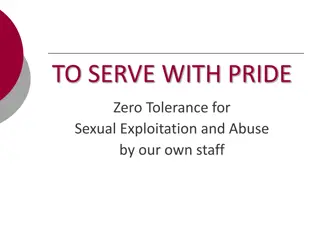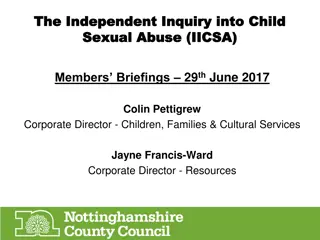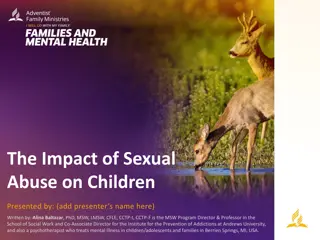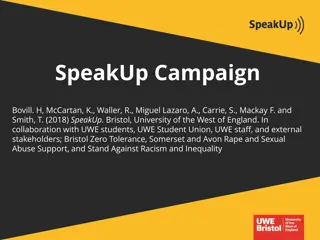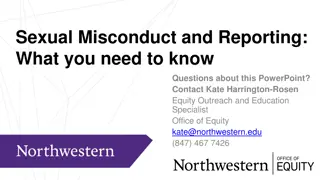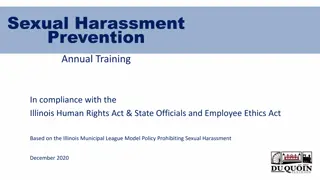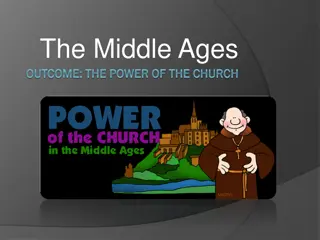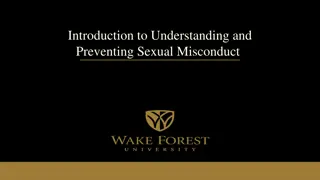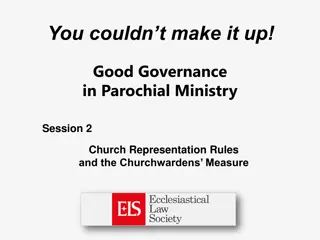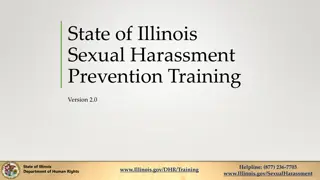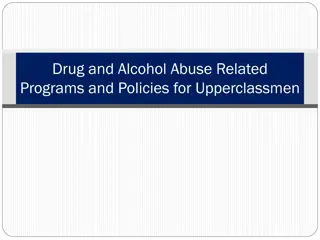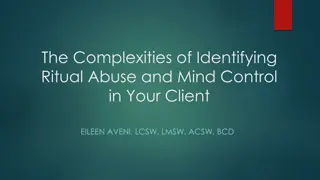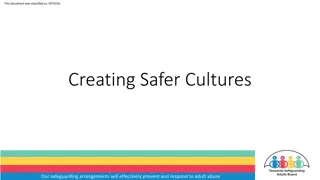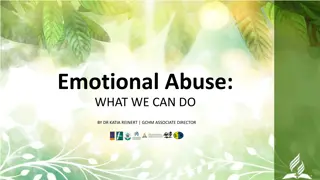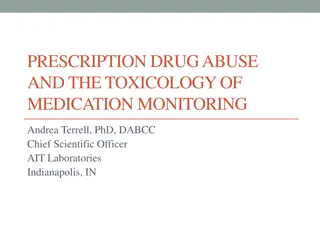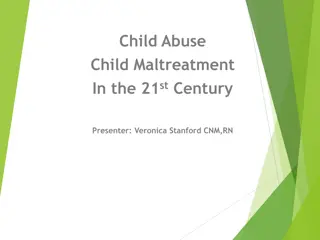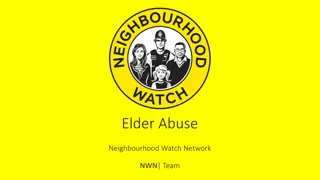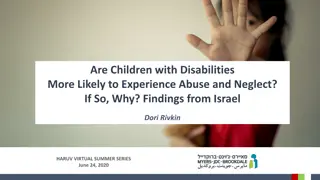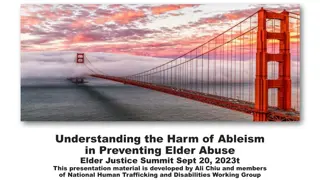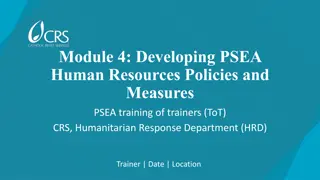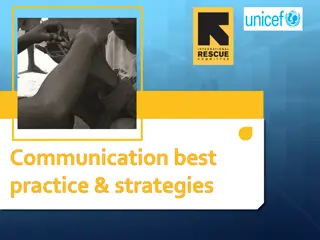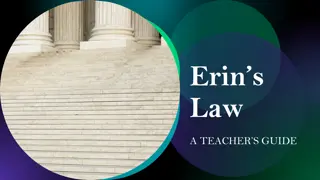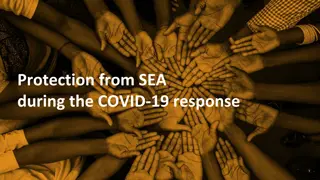Church Responses to Sexual Abuse in Seminaries and Parishes
This article discusses the responses of the Church and seminaries to sexual abuse primarily focusing on minors by Catholic priests in the United States. It highlights key data reports presented to the United States Conference of Catholic Bishops, Church directives on formation for celibacy and sexuality, and the evolution in seminary formation programs to address abusive behavior. The content emphasizes the importance of human formation and education on sexuality for future priests called to celibacy.
Download Presentation

Please find below an Image/Link to download the presentation.
The content on the website is provided AS IS for your information and personal use only. It may not be sold, licensed, or shared on other websites without obtaining consent from the author. Download presentation by click this link. If you encounter any issues during the download, it is possible that the publisher has removed the file from their server.
E N D
Presentation Transcript
Module B Church and Seminary Responses to Sexual Abuse Primarily for Seminaries and Also Parts for Parishes and Dioceses B-1
Church and Seminary Responses to Sexual Abuse of Minors by Catholic Priests in the United States B-2
Main Sources of Data Reports presented to the United States Conference of Catholic Bishops by the John Jay College Research Team, The City University of New York* The Causes and Context of Sexual Abuse of Minors by Catholic Priests in the United States, 1950-2010, March, 2011 The Nature and Scope of Sexual Abuse of Minors by Catholic Priests and Deacons in the United States, 1950- 2002, February 2004 * The two reports are based on data supplied by 97 percent of U.S. archdioceses and dioceses on all clergy accused of sexual abuse of minors B-3
Church Directives on Formation for Celibacy and Sexuality, 1 Pope John Paul II s Pastores dabo vobis, 1992 Introduced for the first time a section on human formation (#43), insisting that the whole work of priestly formation would be deprived of its necessary foundation if it lacked a suitable human formation On contemporary misunderstandings about love and sex, he said, In such a context, an education for sexuality becomes more difficult but also more urgent for those who are called to celibacy (#44) B-4
Church Directives on Formation for Celibacy and Sexuality, 2 The Program of Priestly Formation Guided seminaries on every aspect of preparing future priests and was issued five times by American bishops between 1971 and 2005 Gradual change in the presentation of celibacy and sexuality occurred from 1971 to the present; most notably, the first three editions gave little space or weight to the topics, while the last two considerably expanded the content B-5
Church and Seminary Responses Until 1992 church documents generally did not reflect the necessity of revising seminary formation to deal with reports of abusive sexual behavior by priests Nonetheless, seminaries recognized the need for change and began to modify formation programs substantially by the late 1980s B-6
Involvement of Seminaries Priests with allegations of sexual abuse against minors were enrolled in much higher proportions in some seminaries than others Contrary to widespread opinion, those who attended high school seminaries were not more likely to abuse than those who did not B-7
Phases of Reports and Responses Phase 1 1940s to Mid-1970s Early reports of a few incidents; clergy sexual abuse considered an anomaly; little response Phase 2 Mid-1970s to 1985 Still limited reports of incidents; little official response; seminaries developed some programmatic elements on celibacy and sexuality Phase 3 1985 to 2002 More reports of clergy sexual misconduct came to light, with some response by bishops, more response by seminaries Phase 4 After 2002 Revelations Outpouring of reports of clergy sexual abuse resulted in extensive response by both church officials and seminaries B-8
Phase 1 1940s to Mid-1970s Seminary Response Information about programs available mainly in histories of seminaries Church Response Clergy sexual misconduct considered an anomaly Known reports of incidents are rare, not publically revealed Reports of human or personal formation rarely mentioned in histories 1stPPF issued in 1971 has only minor content on celibacy, none on sexuality Very limited instruction on celibacy, sexuality, and related topics reported by priests of that era Focus in the PPF was on ministry B-9
Phase 2 Mid-1970s to 1985 Church Response Seminary Response Seminaries gradually developed more program content on celibacy, sexuality, and related topics Content added and reported in seminary catalogs on both personal and spiritual topics related to celibacy and sexuality Usually referred to content as personal formation Limited number of abuse cases were known or made public 2ndPPF (1976) added only one new paragraph on the topic of celibacy and sexuality 3rdPPF (1981) added several new paragraphs emphasizing the obligatory nature of celibacy B-10
Phase 3 1985 to 2002 Seminary Response Church Response Pope John Paul II issued Pastores dabo vobis, calling for significant change in formation for priests Apostolic visitation of seminaries called for in 1981 and carried out by American bishops from 1983 to 1988 to evaluate seminaries 4thPPF issued in 1992 with extensive content on celibacy and sexuality Five Principles adopted in 1992 Significant development of formation program content and introduction of human formation Appointed formation advisors for each seminarian to balance the strictly confidential nature of spiritual direction To encourage and assess growth in four areas: human, spiritual, intellectual and pastoral Psychological testing emphasized B-11
Phase 4 After 2002 Revelations Church Response Seminary Response Charter for the Protection of Children and Young People issued in Dallas in 2002 Continued development and enhancement of human formation in virtually all seminaries Nature and Scope Study authorized; issued in 2004 Focus on findings from the visitation with added instruction on celibacy, sexuality, and moral theology, and seminary life Causes and Context Study authorized; issued in 2011 Vatican apostolic visitation of seminaries - 2005-2007; report issued in 2008 5thPPF issued in 2005 with extensive content on celibacy, sexuality, and requirements of human formation Rule of Life in seminaries expanded and tightened B-12
Details of Responses by the Bishops Conference, 1 Five Principles to Guide the Response of Bishops (1992) (1) Respond promptly to all allegations of abuse where there is reasonable belief that abuse has occurred; (2) If such an allegation is supported by sufficient evidence, relieve the alleged offender promptly of his ministerial duties and refer him for appropriate medical evaluation and intervention; (3) Comply with the obligations of civil law regarding reporting of the incident and cooperating with the investigation; (4) Reach out to the victims and their families and communicate sincere commitment to their spiritual and emotional well-being; and (5) Within the confines of respect for privacy of the individuals involved, deal as openly as possible with the members of the community. B-13
Details of Responses by the Bishops Conference, 2 Charter for the Protection of Children and Young People Developed from work of the Ad Hoc Committee on Sexual Abuse, entitled Restoring Trust, 1994 Reports Essential Norms were approved in 2002 and were published as the second part of what is commonly called The Charter or The Dallas Charter The Charter was approved by U.S. Bishops in revised form in 2005 The Charter was revised and approved for a second time in 2011 B-14
Details of Responses by the Bishops Conference, 3 Office of Child and Youth Protection The Charter created an Office of Child and Youth Protection* in 2002 with three assigned tasks: 1. To assist each diocese and eparchy in implementing Safe Environment programs 2. To develop an appropriate compliance and mechanism to assist the Bishops and Eparchies in adhering to the responsibilities set forth in the Charter 3. To prepare a public, annual report describing the compliance of each diocese and eparchy to the Charter s provisions *Officewas changed to Secretariat in 2008 B-15
Details of Responses by the Bishops Conference, 4 National Review Board This consultative body was established in 2002 by the USCCB. Its duties include: 1. reviewing the annual report of the Secretariat of Child and Youth Protection on the implementation of the Charter in each diocese/eparchy 2. making recommendations that emerge from the report, and offering its own assessment regarding its approval and publication to the USCCB President 3. advising the Conference President on future members B-16
Details of Responses by the Bishops Conference, 5 Diocesan Review Boards Each diocese/eparchy will have a review board that will function as a confidential consultative body to the bishop/eparch in discharging his responsibilities. The functions of this board may include: 1. advising the diocesan bishop/eparch in his assessment of allegations of sexual abuse of minors and in his determination of suitability for ministry 2. reviewing diocesan/eparchial policies for dealing with sexual abuse of minors 3. offering advice on all aspects of these cases, whether retrospectively or prospectively B-17
Summary of Responses to Sexual Abuse of Minors by Catholic Priests in the United States Church Directives on Formation for Celibacy Phases of Response to Clerical Sexual Abuse by the Church and by Seminaries Details of Responses by the Bishops Conference - Promulgation of the Five Principles - Development of the Charter for the Protection of Children and Young People - Creation of the Office for Children and Youth Protection - Establishment of the National Review Board and Diocesan/ Eparchical Review Boards B-18
Discussion Questions What other actions have been taken in your institution to prevent clerical sexual abuse? What other preventative measures are needed in the future? How well informed about prevention of abuse are the administrators, faculty, and students of your institution? What more needs to be done to ensure continued progress in understanding and acting on the problem of clerical sexual abuse? Link to USCCB http://www.usccb.org/issues-and-action/child- and-youth-protection/charter.cfm B-19
Prepared by: Sister Katarina Schuth, O.S.F., St. Paul Seminary School of Divinity, University of St. Thomas Technical Associate: Catherine Slight Consultants: Dr. Karen Terry and Margaret Smith, John Jay College of Criminal Justice, authors of major studies on sexual abuse for the USCCB; Dr. Mary Gautier, Center for Applied Research in the Apostolate B-20



